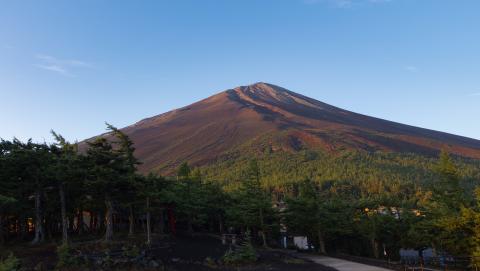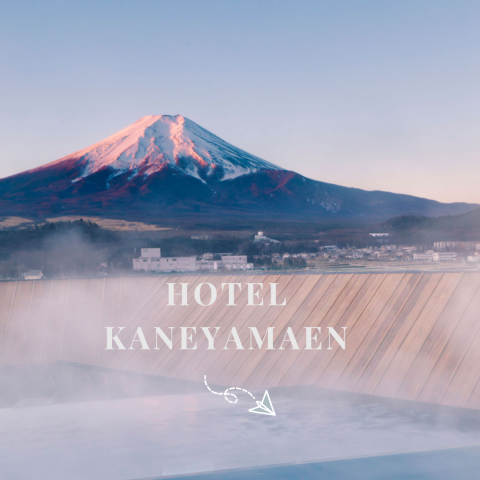Main content starts here.
At the foot of Mt. Fuji in Yamanashi, you can find “power spots” or good luck spots that are overflowing with spiritual energy, where your luck is said to improve just by visiting! Let’s look at a few…
Mt. Fuji Panoramic Ropeway (Kawaguchiko Town)
Mt. Fuji is known as the number one power spot in Japan, and there are also plenty more surrounding the mountain itself. One of these is Mt. Tenjo, the main location for famous Japanese Author Osamu Dazai’s short story "Kachi Kachi Yama,” meaning “crackling mountain” in English. To reach the top, you can take the Mt. Fuji Panoramic Ropeway on a short 3-minute ride from Kawaguchiko-han Station up to Fujimidai Station. Here, you can see the Kawaguchi Lake and Mt. Fuji all in one grand panorama view!

▲View from the Mt. Fuji Panoramic Ropeway
The power spot for this location lies at the top of the ropeway. It is a cute heart-shaped bell named the “Tenjo Bell,” and it is rumored to improve your love life if you ring it while looking at Mt. Fuji. If a family rings it together, it is said to bless them with good health.

▲Tenjo Bell
Close by, you can find the “Rabbit Shrine.” Enshrined here is a rabbit deity. Rabbits are quick on their feet, and many consider them messengers of the gods or a deities of great enlightenment.

▲Rabbit Shrine
The Rabbit Shrine is famous for its cherry blossoms in the spring, and its beautiful views of Mt. Fuji regardless of the season. You can take a one-hour hike up the mountain, which is best enjoyed when the hydrangeas bloom in the summer, or when the leaves turn autumnal reds and oranges in the fall.
More Info
Mt. Fuji Panoramic Ropeway website:
https://www.mtfujiropeway.jp/en/
Address: 1163-1 Azagawa, Fujikawaguchiko, Minamitsuru District, Yamanashi
Shosenkyo Gorge (Kofu City)
Often called Japan’s most beautiful river valley, the Shosenkyo Gorge has even been recognized as a National Heritage Spot by the government.

Those who walk the Shosenkyo promenade can take in the wonders of the four seasons. There is also a ropeway that you can ride to the top, and there you will find a treasure trove of power spots! Notably, there is a great view of Mt. Fuji from the worshipping area.

▲Mt. Fuji from the worshipping area
Wago Gongen
At the top of the mountain, there is a 350-year-old sacred tree that symbolizes both masculinity and femininity, and houses the deity named “Wago Gongen.” This is considered a power spot for blessings involving childbirth and marriage. After worshipping, if you visit the “Ukifuji Hiroba” to view Mt. Fuji, your luck will go up even more!

▲Wago Gongen (sacred tree diety)
Wishing Bell Sanctuary
There is also the “Wishing Bell Sanctuary.” Toss your offering into the heart-shaped entrance of the bell, and if it enters successfully it is said to bring you good luck in relationships!
Yakumo Shrine
At Yakumo Shrine, there is a power spot to pray to the Japanese deity “Susanoo-no-Mikoto” and one of his wives, Kushinadahime, for a happy and blessed marriage.

Yasaburoudake
About a ten-minute walk from the observation deck will take you to “Yasaburoudake,” one of the top power spots at Shosenkyo. The highest peak here is on top of a large rock. If you walk to the edge, you can see some of the most beautiful views of Mt. Fuji and the Southern Alps, spreading out right before your eyes. It is said that some of Mt. Fuji’s sacred energy flows through here, so don’t forget to stop by and absorb all of that good juju.

▲Yasaburoudake
More Info
Shosenkyo website:
https://www.shosenkyo-kankoukyokai.com/en/
Mt. Minobu (Minobu Town)
Kuonji Temple, located at the top of Mt. Minobu, is the head temple of the Nichiren sect of Buddhism. It was established over 700 years ago during the Kamakura period by the great Buddhist priest, Nichiren.

Mt. Minobu is a sacred prayer mountain and said to be a land where many spirits dwell. It is considered a holy land where many lotus sutra believers (on which the Nichiren sect was found) come to visit this temple to pay worship. The entire mountain is a power spot, but the most recommended area can be found at the mountain’s summit, accessible via the ropeway.

▲Views from Mt. Minobu
Hottarakashi Onsen (Yamanashi City)
Hottarakashi Onsen is a wonderful hot spring, and it is a popular day trip for visitors. It offers some of the most magnificent sights of Mt. Fuji and the Kofu Basin.

▲Hottarakashi Onsen
The night views are arguably the most popular, but I personally recommend an early morning visit. They open just before sunrise, so you can enjoy the sunrise while you bathe. The waters are a simple alkaline-based bath, and you are sure to take in tons of good energy from this power spot.

▲Morning sun views, Acchi-no-Yu (Hottarakashi Onsen)

▲Views of Mt. Fuji, Kocchi-no-Yu (Hottarakashi Onsen)
North of the Hottarakashi Onsen area, there is a campsite area.

▲Hottarakashi Campsite

▲View of Mt. Fuji from the Hottarakashi Sanpo Café
More Info
Hottarakashi Onsen website:
http://www.hottarakashi-onsen.com
Address: 1669-18 Yatsubo, Yamanashi-shi, Yamanashi
(10 minutes by car from Yamanashi-shi Station, JR Chuo Line. Taxi fare is estimated at 2,400 yen one way)
Yatsugatake Kogen Bridge (Hokuto City)
At the foot of the Yatsugatake Mountains, the view from the Yatsutake Kogen Bridge is absolutely beautiful. Just on the other side, there's an amazing view of Mt. Fuji can also be seen.

▲Yatsugatake Kougen Bridge (Yellow Bridge)


Near the bridge, you can find Doryuu Falls, another power spot in the area. Doryuu Falls is located in the Nishi-ide district of Oizumi-cho in Hokuto City, Yamanashi. The falls are 10 meters high and 15 meters wide. Its name, which means “spitting dragon,” is said to come from the fact that the numerous small waterfalls gliding down resemble a dragon spitting out water. At an altitude of 1,000 meters above sea level, it is said to have the same atmospheric pressure as a mother's womb, thus granting a sort of healing effect to those who visit.

▲Doryuu Falls
More Info
Address: Higashi-ide, Takane-cho, Hokuto City
(By bus, take a Kiyosato Picnic Bus from Kiyosato Station, JR Koumi Line. Get off at the Yatsugatake-ohashi/Nakamuranojo-mae stop. By taxi, it takes 10 minutes from Kiyosato Station, JR Koumi Line.)
We recommend borrowing an E-bike for traveling in Kiyosato! Because these are electricity-powered bikes, uphill rides are easy! E-bikes are available at the Kiyosato Station General Tourist Information Center next to Kiyosato Station on the JR Koumi Line.
Kiyosato Easy-Cycle website:
https://www.kiyosato.gr.jp/article/easyl-cycle.html
Published on
- April 14, 2022
Share
-

Fuji Subaru Line 5th Station & Mt. Fuji Travel Guide
March 3, 2025
Home of Mt. Fuji > Staff Journal > Power Spots in Yamanashi

